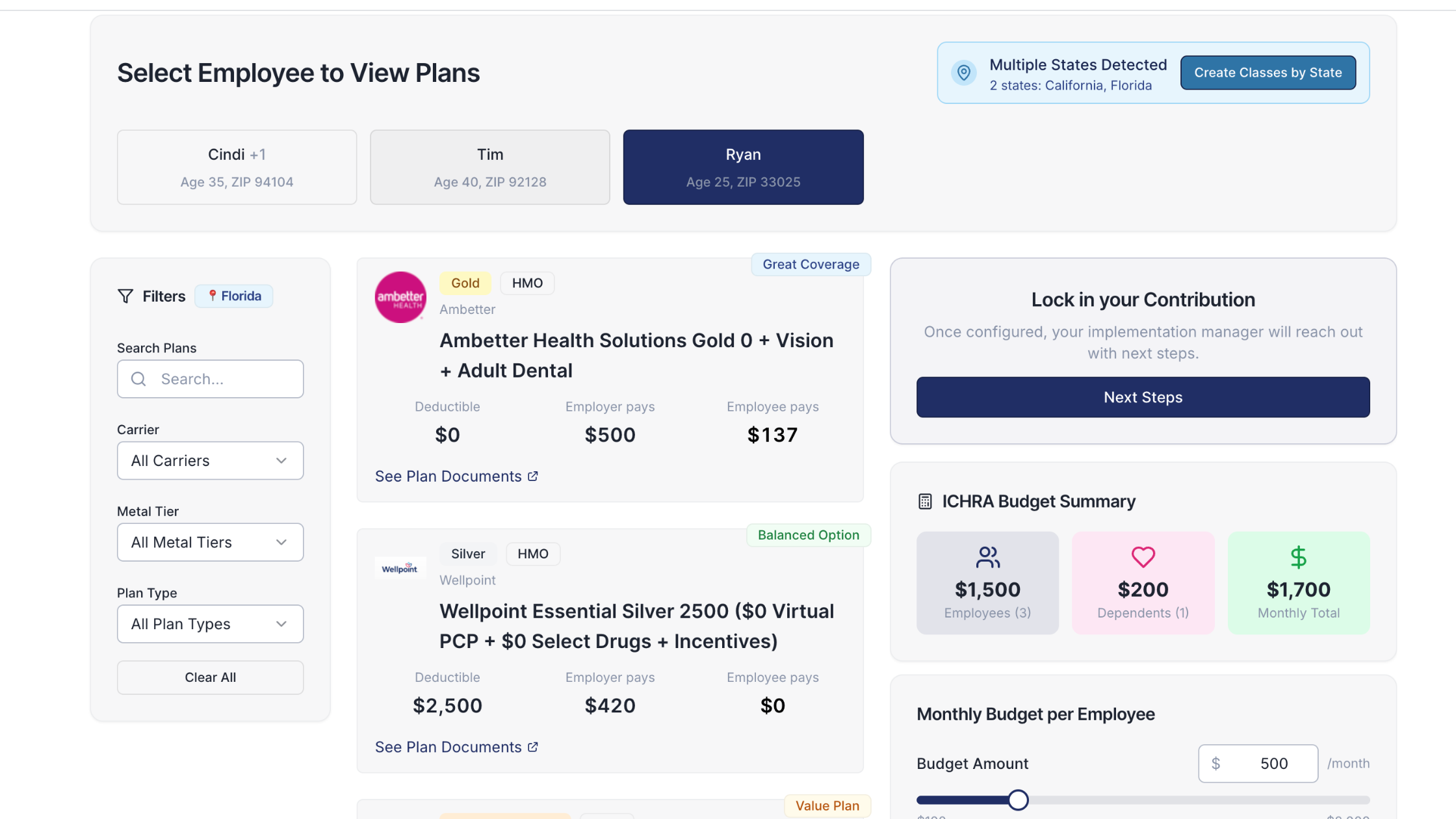Breaking Down the Math: ACA Affordability for ICHRA (Updated for 2026)

ACA Affordability in 2026: How to Know if Your ICHRA Strategy Passes the Test
We often get requests for Affordable Care Act (ACA) affordability analyses. Our team can usually look at an ICHRA funding strategy and know in seconds whether it’s affordable. In this article, we walk you through the math shortcuts that make that possible.
What Is ACA Affordability and Why Does It Matter?
Each year, the IRS sets an affordability benchmark that determines whether employer-sponsored coverage meets ACA requirements. For 2026, coverage is considered affordable if the employee’s required contribution for self-only coverage does not exceed 9.96% of their household income.
That’s a shift from the 2025 threshold of 9.02%, meaning employees can legally be required to pay a slightly higher share toward their premium—and employers don’t need to contribute as much to remain compliant.
Applicable Large Employers (ALEs)—those with 50 or more full-time equivalent employees—must demonstrate affordability to avoid employer shared responsibility payments (ESRP). One of the most straightforward ways to do this is through the Federal Poverty Line (FPL) Safe Harbor.
The 2026 FPL Safe Harbor: Know the Monthly Cap
For calendar-year plans beginning in 2026, the FPL Safe Harbor is based on the 2025 FPL of $15,650 (mainland U.S.). Multiply this number by 9.96%, then divide by 12:
(15,650×0.099612) divided by 12=$129.89
So, if an employee's monthly premium share for the lowest-cost silver plan is $129.89 or less, the coverage is deemed affordable under the FPL Safe Harbor.
For comparison:
- 2025 cap (based on 2024 FPL): $123.33/month
- 2024 cap: $113.00/month
💡 Note: Non-calendar year plans use the affordability threshold and FPL in effect at the start of the plan year. That means the 9.02% threshold still applies to some 2025-starting plans.
How to Calculate ACA Affordability for ICHRA
To determine whether your ICHRA strategy meets the ACA affordability requirement, use this formula:
[Second Lowest Cost Silver Premium] - [Employer ICHRA Contribution] < (Employee’s Annual Income/12 Months) X .0996
Now, let's do some math.
Example 1: FPL Safe Harbor
Imagine an employee in Georgia earning $15,650/year—right at the FPL.
15,65012×0.0996=129.89\frac{15,650}{12} \times 0.0996 = $129.89
As long as the employee’s share of the lowest-cost silver plan is $129.89/month or less, the coverage qualifies as affordable under the FPL Safe Harbor.
Example 2: Income-Based Safe Harbor
If the employee earns $45,000/year:
(45,00012×0.0996)/12=$373.50
In this case, their premium share can be as high as $373.50/month and still be considered affordable.
But remember: under ICHRA non-discrimination rules, you must offer the same contribution method to all employees within a class (e.g., full-time, salaried, hourly). So while a $10 monthly ICHRA contribution may satisfy affordability for a younger employee with a $350 premium, it won't work for a 50-year-old whose plan costs $597.46.
👉 Solution: Use an age-based ICHRA funding strategy—for example, contribute 75% of a gold reference plan's premium for each employee. This ensures consistent purchasing power across age groups and makes it easier to satisfy ACA rules.
Want to Skip the Math? Here's a Shortcut.
Pro Tip: Contributing 100% of the cost of the lowest-cost silver plan for each employee will meet ACA affordability requirements in nearly every scenario.
ACA Affordability and the “Play or Pay” Decision
If your current plan may not meet ACA affordability in 2026, you have two options:
✅ Option 1: Play (Stay Compliant)
Increase your contribution so employees aren’t required to pay more than 9.96% of their income. This avoids IRS penalties and helps maintain employee satisfaction.
⚠️ Option 2: Pay (Face the Penalty)
If you don’t offer affordable coverage, the IRS may assess penalties under Section 4980H.
2026 IRS Penalties
Penalty Structure
- Section 4980H(a) Penalty:
- This penalty applies if you fail to offer minimum essential coverage to at least 95% of full-time employees.
- Triggered when at least one employee qualifies for a premium tax credit via the ACA marketplace.
- The penalty in 2026 is $278.33 monthly per full-time employee, totaling $3,340/year per employee (excluding the first 30)
- Section 4980H(b) Penalty:
- This applies if coverage is offered to 95% of full-time employees but isn't deemed both affordable and of minimum value.
- When employees opt for a subsidized ACA marketplace plan instead, a penalty ensues.
- In 2026, the penalty is $417.50 per month for each such employee, reaching $5,010 annually per affected employee.
What If Your ICHRA Still Feels Unaffordable to Employees?
Even if your ICHRA is technically “affordable,” some employees may still struggle to manage premium costs. Here are a few actions they can take:
- Explore the ACA Marketplace – Employees may qualify for subsidies if the ICHRA is deemed unaffordable.
- Review household budget – Shifting discretionary spending can help absorb premium costs.
- Compare plans – Not all silver plans are equal; employees should shop for one that best fits their needs.
- Check Medicaid eligibility – Some low-income employees may qualify for no-cost coverage.
- Ask your HR team – They may have additional resources or be able to help with strategy changes.
- Research local programs – Some states and counties offer additional assistance.
Final Thoughts: Compliance = Confidence
For Applicable Large Employers (ALEs), keeping coverage affordable isn’t just about avoiding penalties—it’s about giving your workforce access to meaningful care.
To recap:
- The 2026 affordability threshold is 9.96%
- The FPL Safe Harbor limit is $129.89/month
- Penalties can exceed $5,000 per employee annually
- A well-designed ICHRA strategy ensures both compliance and competitiveness
How Venteur Helps
We run ACA affordability audits automatically during onboarding and every renewal. We’re here to help you stay compliant—and strategic.
Got questions? Reach out for an ICHRA compliance review.
You got questions, we got answers!
We're here to help you make informed decisions on health insurance for you and your family. Check out our FAQs or contact us if you have any additional questions.
Explore more related content
What is Venteur
Explore the best human-first Health Insurance platform
Simple, personalized health benefits
Sign up in minutes, define your contribution, and let your employees choose the health plan that works right for them
Integrations to make everything run smoothly
We'll connect with your payroll and finance systems to make deductions and premium payments seamless
Easy onboarding and off-boarding
In just a few clicks, add your roster and make updates on the fly. We'll handle it from there.
Venteur Certified Brokers to help your employees pick the right plan
Our trusted brokers ensure the best outcomes for employees and employers by unlocking health savings and providing unrivaled plan options.
AI-powered plan recommendations to give you confidence while you shop
Backed by 30 years of healthcare data, Venteur’s AI helps employees compare and choose the best plan for their unique situation.
Compliance and reporting because no-duh!
Venteur manages plan administration, reporting, and compliance so you can focus on growing your business.


